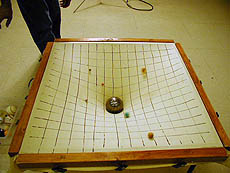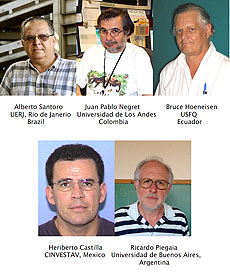Newton, Schrödinger and DZero
 |
| A visualization of a force field created by a stationary object. The massive object at the center of the system creates a stationary force field; one has to determine only how a relatively light object’s motion responds to the force. Photo courtesy University of New Mexico Department of Physics and Astronomy |
Physicists who remember the past are delighted to repeat it.
Nicolaus Copernicus and Galileo Galilei both realized that the sun is pretty much stationary at the center of the solar system. Newton followed with the insight that the force holding planets in their orbits was gravity. With this, the ancient problem of predicting the motion of planets was reduced to finding the motion of an object, the planet, in response to the force exerted by stationary object, the sun. Because the sun is so heavy, it hardly moves, and the gravitational field that it creates does not change. That allows for an immense mathematical simplification. You only need to figure out how one object, the planet, moves in a stationary gravitational field.
In the early part of the 20th century, a very similar situation arose. This time, the problem was to understand the internal structure of atoms. Hydrogen is the simplest atom, containing just one proton and one electron. The force between the two isn't gravitational, but rather electric. The electron's motion is quantum mechanical, and quantum mechanics was not quite fully worked out at the time. But just as the sun is much more massive than a planet and thus can be thought of as nearly stationary, so the proton is much more massive than the electron. Niels Bohr placed the proton at the center of the atom, just as Copernicus placed the sun at the center of the solar system. Erwin Schrödinger based his solution, which underlies all of modern chemistry, upon that idea. Schrödinger only needed to figure out how one object, the electron, moves in a stationary electric field.
In 1977, the situation appeared for a third time. The discovery of the bottom quark, with a relatively large mass, in combination with the realization that mesons contained two quarks, meant that there had to be particles in which a nearly stationary heavy object, the b quark, was bound by a certain force to a light quark moving around it. In this case, the motion is quantum mechanical, just as in the hydrogen atom. The force holding the objects together is the strong nuclear force, about which we are still learning.
In these mesons, several different kinds of light quarks (or antiquarks) can surround the heavy b quark. To the extent that they all are light, they are nearly interchangeable. If the light quark is a d quark, the meson is called B0; if it is an s quark, the meson is called Bs0. In both cases, the heavy quark sits there, basically stationary, and the light quark is a bystander. This is sometimes called the spectator model of B mesons. In this model, the lifetime of the B0 and the Bs0 should be the same because the decay of these mesons is caused by the decay of the b quark. More advanced models predict that the lifetime of the Bs0 should be just a little shorter than that of the B0.
DZero recently made the most precise measurement of the lifetime of the Bs0 meson to date. Along with this, DZero measured the lifetime of the B0 meson. The idea here is that by using similar methods to measure both particles, any particular error that might creep into one measurement will also creep into the other, but then in the ratio of the lifetimes, these two will cancel.
DZero finds that the lifetime of the Bs0 is 1.479 ± 0.023 picoseconds and that the ratio of the Bs0 lifetime over the B0 lifetime is 0.964 ± 0.015. That is not very far from a ratio of 1, which is what the spectator model predicts. The prediction of more complicated unquenched lattice QCD calculations is that this ratio should lie somewhere between 0.996 and 1.000. So in this case, just remembering history gets you very close to the right answer!
—Leo Bellantoni
 |
| Enrique Comacho-Pérez, Jorge Martínez-Ortega and Alberto Sánchez-Hernández, all of CINVESTAV, Mexico, are the primary analysts for this result.
|
 |
| Latin American countries have contributed strongly to DZero over its three-decade existence. The leaders who brought consortia from Argentina, Brazil, Colombia, Ecuador and Mexico into the collaboration are pictured here.
|
|